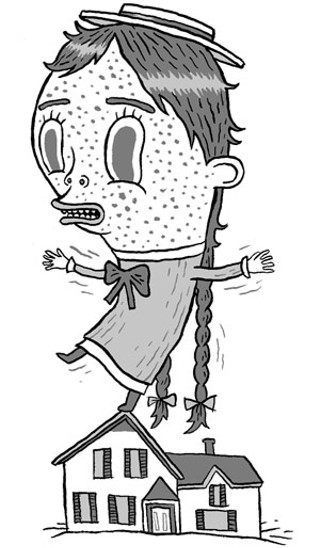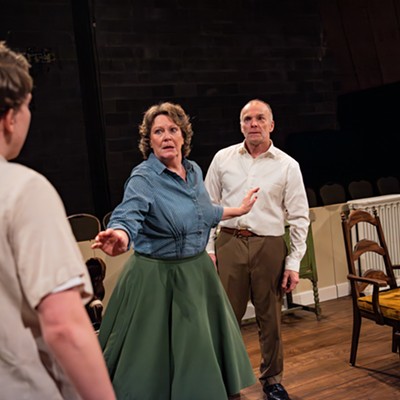Green Gables, the inspiration for Anne of Green Gables in Cavendish, PEI, is an example of the expectations people build when something permeates mass culture. Chantelle MacDonald, who works at the site, knows about high hopes. The house has hosted numerous Anne pilgrims since it became a national historic site in 1937. MacDonald says sometimes people are confused by what they see.
“A lot of people are expecting it to be the house from the movie, which was filmed in Ontario, but it is actually the house that L.M. Montgomery used as her model for the novel,” MacDonald says. “So they have a moment where they realize this isn’t what they thought it was.”
Anne of Green Gables has been continuously in print since it was published in 1908, expanding the name Anne Shirley beyond the bookstore. Merchandise and movie adaptations abound: The 1985 TV mini-series that MacDonald refers to is the most prominent and world famous. Anne of Green Gables---The Musical has played at Charlottetown’s Confederation Centre every summer for more than 40 years and holds the title of Canada’s longest-running musical. There is also a healthy Anne-related tourism industry in PEI. In 2007, 53,000 groups of visitors went to the Anne attractions that dot the island, according to the tourism research centre of UPEI’s Business School. Legendary are the masses of Japanese visitors that come to the island for Akage no An (red-haired Anne), also a long-running animated television series there.
Two books were written to coincide with Anne’s 100th year, featuring the icons Anne Shirley and Lucy Maud Montgomery. Before Green Gables by Budge Wilson (who read at the Halifax International Writers’ Festival on Wednesday), is the prequel to Anne of Green Gables, detailing Anne’s life before she met Matthew Cuthbert at the train station at the beginning of Green Gables. Irene Gammel’s Looking For Anne details Montgomery’s experience writing Anne of Green Gables in 1905.
Anne Shirley exists in the minds of so many readers---even Mark Twain called her the “most loveable child in fiction since the immortal Alice”---and everyone has their own thoughts of what she’s like. Living up to those expectations can be daunting. Budge Wilson had every right to feel reluctant to take on the task of writing the prequel.
“I didn’t know,” Wilson says, “whether I would like writing a novel with the main character being someone that I had not created---because I knew, the one thing I would have to do would be to try and have to replicate Anne.”
Wilson thought about it for two months before saying yes. What finally broke her reluctance was Anne herself and the mystery that Montgomery, intentionally or not, created about Anne’s early life. In that novel, Montgomery includes a chapter called “Anne’s History” where Anne outlines her childhood but does not explain how her over-sized personality was formed. Wilson wanted to give it a try.
“One of the things,” Wilson says, “that made me decide to do it was the big puzzle of how---with the background she had as a young child in two very difficult foster homes and the orphanage that she said at one point in one of the Anne books was the worst---did she get through that and get off that train in PEI and get on the buggy with Matthew and reveal herself as such a lively, feisty, articulate, forward-looking kind of person? How did that happen? And that intrigued me and I wanted to solvethat puzzle.
“During that two months when I was trying to make up my mind, almost the first thing I did was re-read Anne of Green Gables and I found I was much more bewitched by it when I read it at 79 than I had been when I read it, whenever it was, at age nine, 10or 11.”
Wilson developed her own understanding of Anne and let that character inspire her story. How Anne got to be so wordy, strong-willed and optimistic became the thrust of Before Green Gables. “I knew I would have to bring in people that would affect her and make her who she was. I would have to, somehow or other, explain how she got her language, which is different from all the people she lives with and how she got so strong because Anne in Anne of Green Gables is strong. She can stand up to an awful lot but she is also willing to stand up for herself.”
Before Green Gables’ demonstration of Anne’s early childhood is harrowing---Wilson portrays alcoholism, domestic violence and post-partum depression amongst Anne’s foster families---but Wilson reserves the most sympathy for Anne.She recognizes a subversive hero in Anne and thinks that’s part of the reason for her endurance.
“I do feel that over the years in the past, the first generations who read the book lived in a society where women were quite pushed down, they weren’t nearly as vocal as they are now. Anne of Green Gables appealed to women, mainly women and little girls, for her willingness to stand up for herself, to let her temper loose and not just hold herself down all the time and be a good little girl, and I think that appealed to a lot of people...and Anne’s courage---everybody admires courage.
“People have said to me, ‘If Montgomery wanted Anne’s early life talked about she would have written it herself, so why is Budge Wilson doing it?’ because some people had been against me doing this book. I had to say to myself, ‘you know, why didn’t she?’ I have a feeling that the material is too dark and her own life was dark so she wouldn’t want to write about dark things. She wrote, basically, about cheerful things.”
Irene Gammel, who reads on Friday at Spring Garden Library, addresses this disparity between Montgomery’s life and fiction in her book Looking For Anne: How Lucy Maud Montgomery Dreamed Up a Literary Classic. Gammel is a scholar in Canadian literature at Ryerson University and has been researching and writing about Lucy Maud Montgomery for about 10 years. With her book, she focused on the period in the early 20th century when the idea for Anne appeared in Montgomery’s head and she started to write the famous novel.
Gammel’s portrait of Montgomery’s process indicates that Anne of Green Gables was a product of the contemporary culture as much as it was, simply, “inspired.” Montgomery was an avid magazine reader, most of which contained the glamour girl portraits and formula short stories that gelled in her head and formed the basis of Anne. Montgomery is also portrayed as a very human writer, prone to the same insecurities, narcissism, distractions and ambition as anyone who practises the craft.
Along with outlining the influences of Anne, Gammel’s book also reveals the product of Montgomery’s habitual daydreaming. What Montgomery lacked in warm familial relationships was Anne Shirley’s gain since Green Gables represents, according to Gammel, the kind of emotionally rich life Montgomery wished she'd had.
“Those elements in her life,” Gammel says, “the kind of non-demonstrative grandmother and the irritable grandfather who were not able to provide her all of these things, I think she took that and dreamt her way out of that and channelled it into something many, many people could identify with. Many sense the loneliness behind the text and a desperate hunger for love that’s very much Maud’s own and we see it there in the book with Anne Shirley.”
All this can make a re-reading of Green Gables a little sad but Gammel contends that the writing of the book for Montgomery spoke to her ambition to succeed as a writer which, in and of itself, is inspiring.
“Take a look at Maud Montgomery: You can just dismiss Anne and say it’s just a fairytale but the fact is, for Maud, the writing for her was incredible transformative. She did create her own career out of very little.”
Two-thousand-and-eight is Anne’s year: Just last weekend a lengthy piece by Margaret Atwood on Anne’s staying power appeared in the British Guardian. She'llhave a future in mass culture, too: A television prequel, independent of Wilson’s, has been produced for CTV and tentatively scheduled for 2009. Apparently Anne’s outspokenness and spirit will never go out of style.Green Gables, the inspiration for Anne of Green Gables in Cavendish, PEI, is an example of the expectations people build when something permeates mass culture. Chantelle MacDonald, who works at the site, knows about high hopes. The house has hosted numerous Anne pilgrims since it became a national historic site in 1937. MacDonald says sometimes people are confused by what they see.
“A lot of people are expecting it to be the house from the movie, which was filmed in Ontario, but it is actually the house that L.M. Montgomery used as her model for the novel,” MacDonald says. “So they have a moment where they realize this isn’t what they thought it was.”
Anne of Green Gables has been continuously in print since it was published in 1908, expanding the name Anne Shirley beyond the bookstore. Merchandise and movie adaptations abound: The 1985 TV mini-series that MacDonald refers to is the most prominent and world famous. Anne of Green Gables---The Musical has played at Charlottetown’s Confederation Centre every summer for more than 40 years and holds the title of Canada’s longest-running musical. There is also a healthy Anne-related tourism industry in PEI. In 2007, 53,000 groups of visitors went to the Anne attractions that dot the island, according to the tourism research centre of UPEI’s Business School. Legendary are the masses of Japanese visitors that come to the island for Akage no An (red-haired Anne), also a long-running animated televisionseries there.
Two books were written to coincide with Anne’s 100th year, featuring the icons Anne Shirley and Lucy Maud Montgomery. Before Green Gables by Budge Wilson (who read at the Halifax International Writers’ Festival on Wednesday), is the prequel to Anne of Green Gables, detailing Anne’s life before she met Matthew Cuthbert at the train station at the beginning of Green Gables. Irene Gammel’s Looking For Anne details Montgomery’s experience writing Anne of Green Gables in 1905.
Anne Shirley exists in the minds of so many readers---even Mark Twain called her the “most loveable child in fiction since the immortal Alice”---and everyone has their own thoughts of what she’s like. Living up to those expectations can be daunting. Budge Wilson had every right to feel reluctant to take on the task of writing the prequel.
“I didn’t know,” Wilson says, “whether I would like writing a novel with the main character being someone that I had not created---because I knew, the one thing I would have to do would be to try and have to replicate Anne.”
Wilson thought about it for two months before saying yes. What finally broke her reluctance was Anne herself and the mystery that Montgomery, intentionally or not, created about Anne’s early life. In that novel, Montgomery includes a chapter called “Anne’s History” where Anne outlines her childhood but does not explain how her over-sized personality was formed. Wilson wanted to give it a try.
“One of the things,” Wilson says, “that made me decide to do it was the big puzzle of how---with the background she had as a young child in two very difficult foster homes and the orphanage that she said at one point in one of the Anne books was the worst---did she get through that and get off that train in PEI and get on the buggy with Matthew and reveal herself as such a lively, feisty, articulate, forward-looking kind of person? How did that happen? And that intrigued me and I wanted to solvethat puzzle.
“During that two months when I was trying to make up my mind, almost the first thing I did was re-read Anne of Green Gables and I found I was much more bewitched by it when I read it at 79 than I had been when I read it, whenever it was, at age nine, 10or 11.”
Wilson developed her own understanding of Anne and let that character inspire her story. How Anne got to be so wordy, strong-willed and optimistic became the thrust of Before Green Gables. “I knew I would have to bring in people that would affect her and make her who she was. I would have to, somehow or other, explain how she got her language, which is different from all the people she lives with and how she got so strong because Anne in Anne of Green Gables is strong. She can stand up to an awful lot but she is also willing to stand up for herself.”
Before Green Gables’ demonstration of Anne’s early childhood is harrowing---Wilson portrays alcoholism, domestic violence and post-partum depression amongst Anne’s foster families---but Wilson reserves the most sympathy for Anne.She recognizes a subversive hero in Anne and thinks that’s part of the reason forher endurance.
“I do feel that over the years in the past, the first generations who read the book lived in a society where women were quite pushed down, they weren’t nearly as vocal as they are now. Anne of Green Gables appealed to women, mainly women and little girls, for her willingness to stand up for herself, tolet her temper loose and not just holdherself down all the time and be a good little girl, and I think that appealed to a lot of people...and Anne’s courage---everybody admires courage.
“People have said to me, ‘If Montgomery wanted Anne’s early life talked about she would have written it herself, so why is Budge Wilson doing it?’ because some people had been against me doing this book. I had to say to myself, ‘you know, why didn’t she?’ I have a feeling that the material is too dark and her own life was dark so she wouldn’t want to write about dark things. She wrote, basically, about cheerful things.”
Irene Gammel, who reads onFriday at Spring Garden Library, addresses this disparity between Montgomery’s life and fiction in her book Looking For Anne: How Lucy Maud Montgomery Dreamed Up a Literary Classic. Gammel is a scholar in Canadian literature at Ryerson University and has been researching and writing about Lucy Maud Montgomery for about 10 years. With her book, she focused on the period in the early 20th century when the idea for Anne appeared in Montgomery’s head and she started to write the famous novel.
Gammel’s portrait of Montgomery’s process indicates that Anne of Green Gables was a product of the contemporary culture as much as it was, simply, “inspired.” Montgomery was an avid magazine reader, most of which contained the glamour girl portraits and formula short stories that gelled in her head and formed the basis of Anne. Montgomery is also portrayed as a very human writer, prone to the same insecurities, narcissism, distractions and ambition as anyone who practises the craft.
Along with outlining the influences of Anne, Gammel’s book also reveals the product of Montgomery’s habitual daydreaming. What Montgomery lacked in warm familial relationships was Anne Shirley’s gain since Green Gables represents, according to Gammel, the kind of emotionally rich life Montgomery wished she'd had.
“Those elements in her life,” Gammel says, “the kind of non-demonstrative grandmother and the irritable grandfather who were not able to provide her all of these things, I think she took that and dreamt her way out of that and channelled it into something many, many people could identify with. Many sense the loneliness behind the text and a desperate hunger for love that’s very much Maud’s own and we see it there in the book with Anne Shirley.”
All this can make a re-reading of Green Gables a little sad but Gammel contends that the writing of the book for Montgomery spoke to her ambition to succeed as a writer which, in and of itself, is inspiring.
“Take a look at Maud Montgomery: You can just dismiss Anne and say it’s just a fairytale but the fact is, for Maud, the writing for her was incredible transformative. She did create her own career out of very little.”
Two-thousand-and-eight is Anne’s year: Just last weekend a lengthy piece by Margaret Atwood on Anne’s staying power appeared in the British Guardian. She'llhave a future in mass culture, too: A television prequel, independent of Wilson’s, has been produced for CTV and tentatively scheduled for 2009. Apparently Anne’s outspokenness and spirit will never go out of style.
















